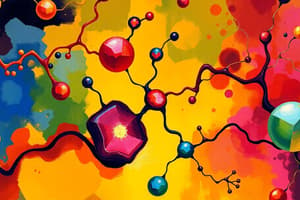Podcast
Questions and Answers
Which of the following best describes the concept of chemical reactivity?
Which of the following best describes the concept of chemical reactivity?
- The study of metabolic processes in living organisms
- The equilibrium state between forward and backward reactions
- The way energy is transferred from one place to another
- The interaction of a substance with other substances to form final products (correct)
In biochemistry, what is the function of lipids?
In biochemistry, what is the function of lipids?
- Energy storage and cellular structure (correct)
- Enzyme catalysis
- Cell membrane transport
- Genetic information storage
What is the main focus of thermodynamics?
What is the main focus of thermodynamics?
- Equilibrium in chemical reactions
- Metabolic pathways in cells
- The structure of biomolecules
- Energy transfer and transformation (correct)
Which type of chemical reaction involves two substances swapping ions to form new compounds?
Which type of chemical reaction involves two substances swapping ions to form new compounds?
What is the key characteristic of chemical equilibrium?
What is the key characteristic of chemical equilibrium?
Why is understanding the structure of biomolecules important in biochemistry?
Why is understanding the structure of biomolecules important in biochemistry?
What is the term used to refer to the sum of all biochemical reactions that take place inside a living organism?
What is the term used to refer to the sum of all biochemical reactions that take place inside a living organism?
Which type of reactions involve the breakdown of polymers to monomers?
Which type of reactions involve the breakdown of polymers to monomers?
What are the main substances involved in maintaining the good healthy status in metabolic processes?
What are the main substances involved in maintaining the good healthy status in metabolic processes?
Which term refers to the set of biochemical reactions where small molecules undergo combinations and transformations to form big molecules?
Which term refers to the set of biochemical reactions where small molecules undergo combinations and transformations to form big molecules?
What regulates the metabolic processes inside living cells?
What regulates the metabolic processes inside living cells?
Which type of compounds are mainly composed of amino acids molecules linked together by peptide bonds?
Which type of compounds are mainly composed of amino acids molecules linked together by peptide bonds?
Which carbon atom in an amino acid is typically indicated using a letter from the Greek alphabet?
Which carbon atom in an amino acid is typically indicated using a letter from the Greek alphabet?
Which of the following amino acids is considered essential and cannot be synthesized by the body?
Which of the following amino acids is considered essential and cannot be synthesized by the body?
What type of bond is formed between the alpha-amino group of one amino acid and the alpha-carboxyl group of another?
What type of bond is formed between the alpha-amino group of one amino acid and the alpha-carboxyl group of another?
Which group is located at the left-end of a polypeptide chain?
Which group is located at the left-end of a polypeptide chain?
Out of the following amino acids, which one is classified as 'semiessential' for growing children but not essential for adults?
Out of the following amino acids, which one is classified as 'semiessential' for growing children but not essential for adults?
Which type of amino acids can be synthesized by the body and are not required from dietary sources?
Which type of amino acids can be synthesized by the body and are not required from dietary sources?
Flashcards are hidden until you start studying
Study Notes
Chemical Reactivity and Biochemistry
- Chemical reactivity refers to the ability of atoms or molecules to form new substances through chemical reactions.
- Lipids have various functions in biochemistry, including energy storage, cell signaling, and structural roles.
Thermodynamics
- The main focus of thermodynamics is the study of energy transformations and the relationships between heat, work, and energy.
Types of Chemical Reactions
- Double displacement reactions involve two substances swapping ions to form new compounds.
- Hydrolysis reactions involve the breakdown of polymers to monomers.
Chemical Equilibrium
- The key characteristic of chemical equilibrium is that the rates of forward and reverse reactions are equal.
Biomolecules
- Understanding the structure of biomolecules is important in biochemistry because it allows us to understand their functions and interactions.
- The term "metabolism" refers to the sum of all biochemical reactions that take place inside a living organism.
- Anabolic reactions involve the combination and transformation of small molecules to form large molecules.
Metabolic Processes
- Carbohydrates, proteins, and fats are the main substances involved in maintaining a healthy status in metabolic processes.
- Metabolic processes are regulated by hormones and enzymes inside living cells.
Amino Acids and Proteins
- Proteins are mainly composed of amino acids molecules linked together by peptide bonds.
- The alpha carbon atom in an amino acid is typically indicated using a letter from the Greek alphabet.
- Tryptophan is an essential amino acid that cannot be synthesized by the body.
- Peptide bonds are formed between the alpha-amino group of one amino acid and the alpha-carboxyl group of another.
- The amino group is located at the left-end of a polypeptide chain.
- Arginine is a semiessential amino acid for growing children but not essential for adults.
- Nonessential amino acids can be synthesized by the body and are not required from dietary sources.
Studying That Suits You
Use AI to generate personalized quizzes and flashcards to suit your learning preferences.



